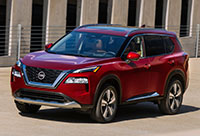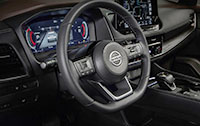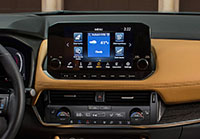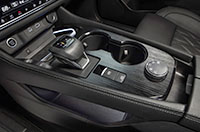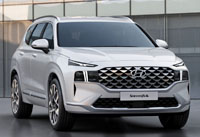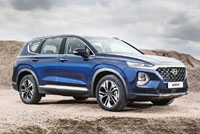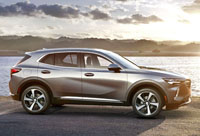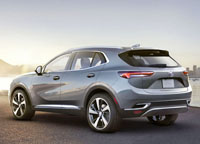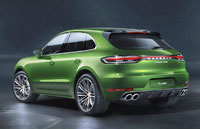
Have you checked out Kia’s latest SUV lineup lately? It’s gone from all curves to sharp angles and complex creases, not unlike its sister-brand Hyundai’s updated crossover lineup.
The hierarchy of Kia SUV models now includes the entry-level Seltos, the always future-think Soul (which includes an EV option), the second-rung Niro (which provides plug-in hybrid and EV variants), the compact Sportage, the mid-size three-row Sorento, and finally the larger and longer mid-size three-row Telluride, with only the Niro and Sportage needing updates to the brand’s edgier new design language.
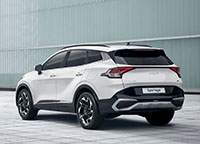
Heck, even the new Carnival minivan (which replaced the Sedona) looks like a chunky SUV now, while the always sharp looking Stinger was also updated for 2022, whereas the mid-size K5 (nee Optima) sedan received its redesign for 2021, as did the subcompact Rio (although not as thoroughly) that’s now only available as a hatch (you might find a heavily discounted 2020 Rio sedan if you look far and wide enough). The compact Forte sedan and hatchback, on the other hand, are expected to be refreshed for 2022, soon putting the entire South Korean brand at the leading edge of modern-day styling.
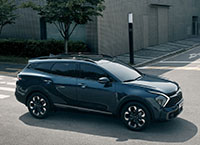
While all of the new Kia SUV designs are advanced looking, the new Sportage might just be the most futuristic of all. Such was the case for the outgoing Sportage when its third-generation debuted back in 2010 and fourth-gen model arrived in 2016, the latter looking a bit like a scaled down Porsche Cayenne. This made sense considering all the German designers filling up the brand’s studios, as does the new 2023 version’s similarities to Audi’s Q8 and Lamborghini’s Urus.
This means the new fifth-gen Sportage should catch the gaze of passersby, although some of these will merely be trying to figure out where the headlamps are. In fact, these are integrated into two boomerang-shaped LED clusters beside the wide glossy black front grille, which itself is situated under a couple of narrow, horizontal nostril-like vents. While a somewhat radical redesign, it should still be pleasing to most compact SUV buyers that tend to want sporty yet practical alternatives to their less-appealing cars.
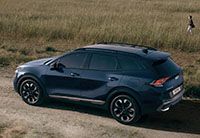
From the side view, the new Sportage provides more aggressive sculpting on the door panels than most rivals, plus a narrow greenhouse on top, for increased visual length, while some stylish detailing on the lower rockers gives it that critically important SUV look.
The new Sportage appears more conventional from its hind end, thanks to body-wide taillights that add to its wide-looking stance, plus a thin mid-section that almost makes it seem as if it was stretched into place. All of these delicate details support a substantive rear bumper that’s visual extended from the just-mentioned black rocker panels, continuing upward to enclose about two-thirds the CUV’s backside, before being capped off by some angular metal-like trim mirroring a similar treatment on the side rockers and lower front fascia, the latter items surrounding two LED fog lights. The entire package rolls on some similarly edgy alloy wheels that look quite large in the as-shown trim, and featuring machine-finishing with glossy-black pockets.

“Reinventing the Sportage gave our talented design teams a tremendous opportunity to do something new; to take inspiration from the recent brand relaunch and introduction of EV6 to inspire customers through modern and innovative SUV design,” commented Karim Habib, Senior Vice President and Head of Global Design Center, in a press release. “With the all-new Sportage, we didn’t simply want to take one step forward but instead move on to a different level in the SUV class.”
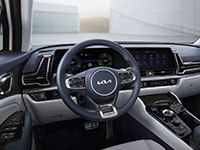
Kia calls its new design language “Opposites United”, a theme that continues inside the cabin where uniquely shaped HVAC vents and horizontally-organized instrument panel trim joins up to form parentheses-like structures that incorporate a very large dual-display primary gauge cluster and infotainment touchscreen within.
The large single-screen setup pulls forward a driver display/infotainment design used recently by both Kia and its parental Hyundai brand, which must be said is similar to Mercedes’ MBUX dash design. Ironically (this being a Kia), it incorporates some camera technologies that are much more advanced than anything on offer from the German luxury brand, particularly its rear-facing camera system that automatically shows right/left rearward views when flicking either turn signal.
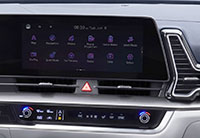
A row of switches continues the horizontal theme just underneath, integrating a well-organized two-zone auto HVAC interface at its mid-point, all before a gently sloping piano-black lacquered centre console gets stuffed full of drive functions such as an engine start/stop button, a rotating gear selection dial, a driving mode selector, and more, while switches for the heatable and cooled front seats, plus the heated steering wheel can be found right next door. A wireless charging pad probably sits under a lidded compartment just in front of this cluster of controls, plus all the expected USB ports and other connectivity/charging alternatives.
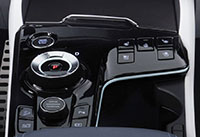
“When you see the all-new Sportage in person, with its sleek but powerfully dynamic stance, and when you sit inside the detailed-oriented cabin with its beautifully detailed interior and first-class materials, you’ll see we have achieved those goals and set new benchmarks,” continued Habib. “In the all-new Sportage, we believe you can see the future of our brand and our products.”
So far, Kia hasn’t shown off any other details, such as the new Sportage’s front and rear seats or its cargo area, but interior capacities should be similar to the new Hyundai Tucson that shares the Sportage’ underpinnings. That compact crossover SUV has grown in size since also being renewed for 2022, now stretching 4,605 mm (181.3 inches) from front to back, making it 155 mm (6.1 in) lengthier than its predecessor, with a 86 mm (3.4 in) longer wheelbase at 2,751 mm (108.3 in), while it’s about half an inch (12-13 mm) wider and similarly taller than the 2021 crossover it sent packing.
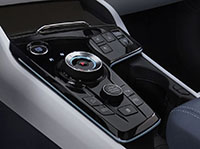
Kia’s Sportage has long shared its mechanical setup with the Tucson too, so we’re expecting a version of the same 2.5-litre four-cylinder powerplant that currently puts out 190 horsepower and 182 lb-ft of torque in the 2022 Hyundai. The new Tucson also features an efficient eight-speed automatic gearbox across its entire trim line, which should be the only transmission used in the Sportage too, while Hyundai’s compact SUV includes both FWD and AWD alternatives, common in this class.
Of course, we’ll get more details when the new 2023 Sportage arrives, which should be sometime in calendar year 2022, at which point we should also find out if it receives an off-road focused X-Line variant, and/or the Tucson’s electrified power units, which currently include both hybrid and plug-in hybrid alternatives.
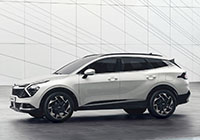
For the time being, Kia is offering the latest 2022 Sportage with up to $1,000 in additional incentives, while buyers of 2021 models get up to $2,500 off. Also notable, CarCostCanada members are currently saving an average of $2,386, so check our 2022 and 2021 Kia Sportage Canada Prices pages for all the details, including complete trim pricing with all available options and colours.
Additionally, find out how the CarCostCanada system works so you can save the most money possible when purchasing your next new vehicle purchase. A CarCostCanada membership provides manufacturer rebate information, factory financing and leasing deals, plus dealer invoice pricing that can save you thousands on its own. Also, be sure to download the free CarCostCanada app from the Google Play Store or Apple Store, so you’ll have all of this valuable info on your personal device exactly when you need it.
Story by Trevor Hofmann
Photos by Kia

